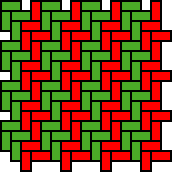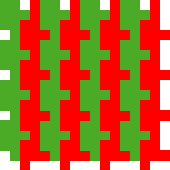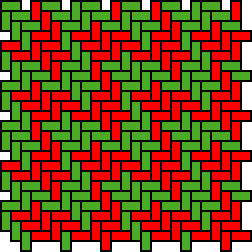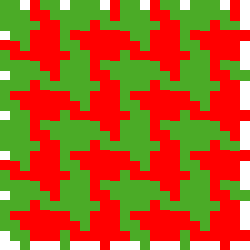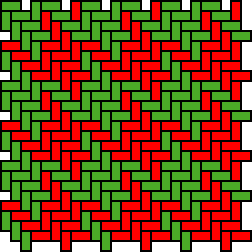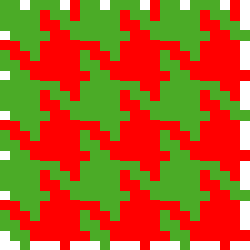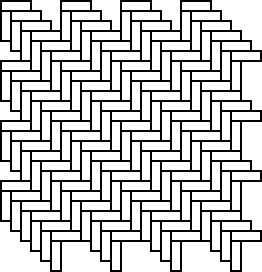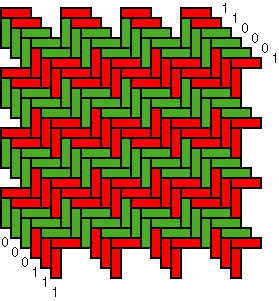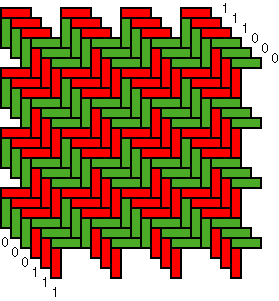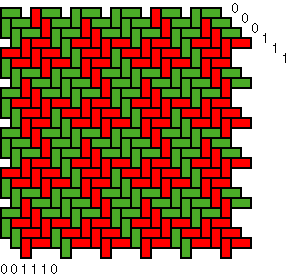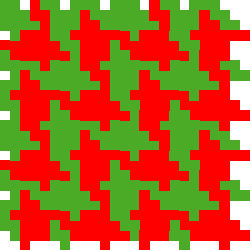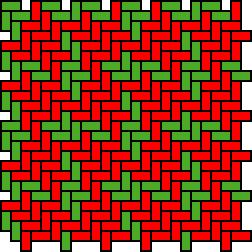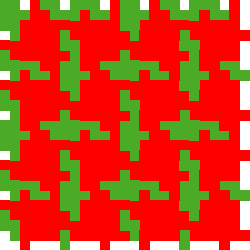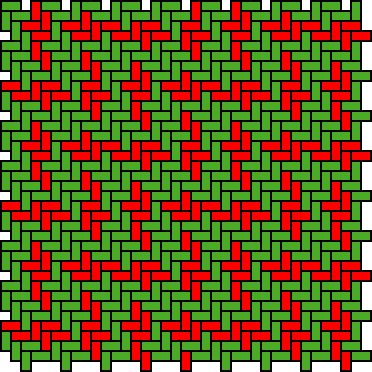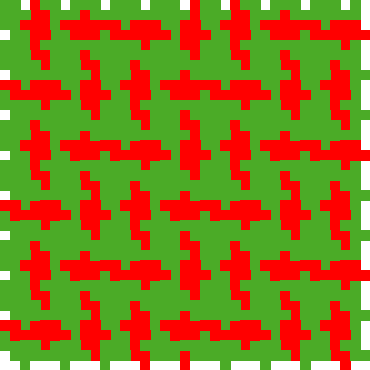|
Examples from Mexico and Mozambique Paulus Gerdes Mozambican Ethnomathematics
Research Centre, C.P. 915,
Abstract In the chapter “Exploring plaited
plane patterns among the Tonga in Inhambane (Mozambique)” a class of plane
patterns is analysed that may be encountered on twill-plaited baskets made
by Tonga artisans, where coloured strands alternate with groups of natural-coloured
strands. These patterns are not the result of changes in the weaving. Throughout
(large parts of) the texture the twill remains the same (2/2, 3/3). The
patterns, on the contrary, are produced by the use in both weaving directions
of groups of n strands whereby one strand is coloured and the other n-1
strands maintain their natural colour. In both weaving directions, the
plane patterns have the same periodicity (period = n).
The present chapter will present examples of other colourings of regular twill plaited mats and baskets. The first three examples come from the state of Oaxaca in the south of Mexico. They appear on baskets and purses I acquired in November 2000 and July 2001 at several markets in Mexico city. In all cases the twill used is 2/2. Photograph 1 presents a part of a small purse. In both weaving directions two coloured strands come after two natural strands; in both weaving directions the period is 4. Using the symbols 0 and 1 for each natural strand and each coloured strand, respectively, the pattern may be described as [2/2: 0011, 0011]. Figure 1 presents the woven texture and Figure 2 its visual image with two-colour symmetry. Photograph 2 presents a part of another small purse. Now, each time, three coloured strands follow three natural strands. In both weaving directions the period is 6. The pattern may be denoted by [2/2: 000111, 000111]. Figure 3 presents the woven texture and Figure 4 its visual image with two-colour symmetry. Photograph 3 shows the wall of a cylindrical basket. Each time, four coloured strands follow after four natural strands. In both weaving directions the period is 8. The pattern may be denoted by [2/2: 00001111, 00001111]. Figure 5 presents the woven texture and Figure 6 its visual image with two-colour symmetry. The same pattern may also be observed on the bottom left corner of a Tonga handbag from the Southeast of Mozambique (Photograph 4). The following examples are from the Makhuwa in the Northeast of Mozambique. Photograph 5 presents a ekhapiaka basket with the [2/2: 000000111111, 000000111111] pattern of dimensions 12×12. Photograph 6 presents the two faces of a beautiful handbag from coastal district of Mecufi in the Cabo Delgado Province. In the centre and above the centre two plane patterns may be observed. If one takes the starting position as in the diagram in Figure 7, the codes of the two patterns are [3/3: 000111, 110001] and [3/3: 000111, 111000] (see Figures 8 and 9). To finish the top of the back side the weaver changed the twill from 3/3 to 2/2 and produced a part with the pattern [2/2: 001110, 000111] (see Figure 10). Photograph 7 presents another handbag. At the crossing of the colours a fragment of the pattern with code [2/2: 001111, 001111] may be observed (see Figure 11). Photograph 8 shows a basket with a very exceptional pattern that is kept at the National Ethnological Museum of Nampula (object Y4/257/95). The twill is 2/2, and the periods are not equal; they are 5 and 6, respectively. The pattern may be denoted as [2/2: 00011, 001100] (see Figure 12). Further examples from the Makhuwa are presented in (Gerdes, 2004). The examples presented in this chapter
reflect the creativity of the basket weavers from Mexico and Mozambique.
For mathematicians it may be interesting to determine all patterns in the
twill m/m with periods p and q.
Figure 1: Woven texture of the pattern [2/2: 0011, 0011]
Figure 2: Visual image of the pattern [2/2: 0011, 0011]
Figure 3: Woven texture of the pattern [2/2: 000111, 000111]
Figure 4: Visual image of the pattern [2/2: 000111, 000111]
Figure 5: Woven texture of the pattern [2/2: 00001111, 00001111]
Figure 6: Visual image of the pattern [2/2: 00001111, 00001111]
Figure 7: Starting position for the colouring
Figure 8: Pattern [3/3: 000111, 110001]
Figure 9: Pattern [3/3: 000111, 111000]
(a)
(b) Figure 10: (a,b) Woven texture and visual image of the pattern [2/2: 001110, 000111]
(a)
(b) Figure 11: (a,b) Woven texture and visual image of the pattern [2/2: 001111, 001111]
(a)
(b) Figure 12:(a,b) Woven texture and visual image of
the pattern [2/2: 00011, 001100]
Photograph 1: Part of a purse from Oaxaca (Mexico)
Photograph 2: Part of a purse from Oaxaca (Mexico)
Photograph 3: Wall of a cylindrical basket from Oaxaca (Mexico)
Photograph 4: Tonga handbag from the Southeast of Mozambique
Photograph 5: Makhuwa basket from the Northeast of Mozambique
(a)
(b) Photograph 6: (a, b) Two faces of a Makhuwa handbag
Photograph 7: Makhuwa handbag
Photograph 8: Makhuwa basket with exceptional pattern
References
|
